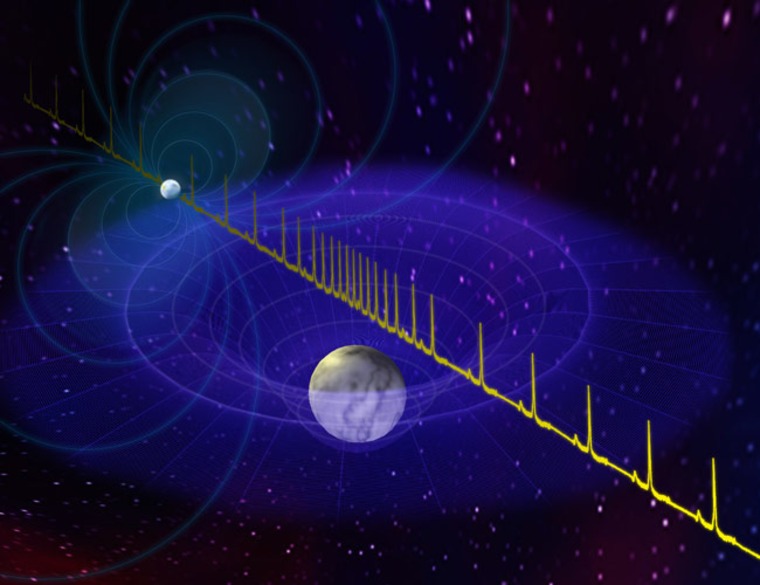Located about 3,000 light-years away in the direction of the constellation Scorpio, a newly spotted neutron star is the largest ever discovered to date.
The difference between the neutron star at sky coordinates J1903+0327 and the new one at J1614-2230 is only about half the mass of our sun. But considering that a thimbleful of neutron star material weighs roughly 500 million tons, the new record-holder has some serious gravitas.
For one thing, scientists didn't know for sure that neutron stars could get as big as J1614-2230, which is about twice as massive as the sun. Its discovery by Paul Demorest, with the National Radio Astronomy Observatory, and colleagues gives physicists a new toehold on understanding what happens when protons and electrons give up the fight against gravity and collapse into neutrons.
Particle-smashers on Earth, such as the new Large Hadron Collider near Geneva, Switzerland, can't compete with Mother Nature when it comes to packing.
"Neutron stars are some of the best astronomical objects to probe fundamental physics itself. They are the most dense form of matter that exists in stable configurations," Demorest told Discovery News.
Only black holes are denser. But since light can't escape from these gravitational pits, black holes keep their inner workings to themselves.
Not so with neutron stars, especially those that have companions, like the white dwarf star in mutual orbit with J1614-2230.
The neutron star — the dense remnant of what was once a star roughly 20 times bigger than the sun — is a stable and fast spinner. It makes 317 revolutions per second, which generates traceable radio waves at regular intervals.
What's interesting is what happens to those signals as they pass through the companion object. The timing of the pulses changes slightly due to the white dwarf's gravity, a phenomenon predicted by Albert Einstein's theory of general relativity and tested by Harvard astrophysicist Irwin Shapiro in the 1960s.
Scientists can use the timing measurements to figure out how big both objects are — if they can get clear signals from the pulsar directly and from when its signals are distorted by the companion object's gravity. By a fortuitous alignment of geometry, Earth has an edge-on view to J1614-2230 and its orbiting companion, providing scientists with one of their most precise measurements yet of the so-called Shapiro Delay.
While many neutron stars are part of binary systems, it's very rare to find one edge-on, noted Demorest.
"It's one of the cleanest measurements you can make. It's a very direct measure of the theory of relativity," he said. "In this system, at certain times during the orbit the pulses pass close to the white dwarf star and then reach us here on Earth. As they pass through the white dwarf star, they have to pass by its relatively strong gravitational field. The pulses experience a delay... and then when the white dwarf is behind the pulsar, we see much less delay."
Most computer models can't account for neutron stars bigger than 1.5 times the mass of the sun without resorting to exotic particles like hyperons or condensates.
"If you want to reach two solar masses, it's a lot harder to make a neutron star that's not just neutrons. It tests the ability of the particles to hold up," Feryal Ozel, an assistant professor of astronomy and physics at University of Arizona, told Discovery News.
"Even the difference between a 1.8-solar-mass neutron star and a two-solar-mass object is quite a big one. We search for these things all the time. The fact that this was a two-solar-mass object is significant," Ozel said.
A report by Demorest and colleagues appears in this week's Nature.
